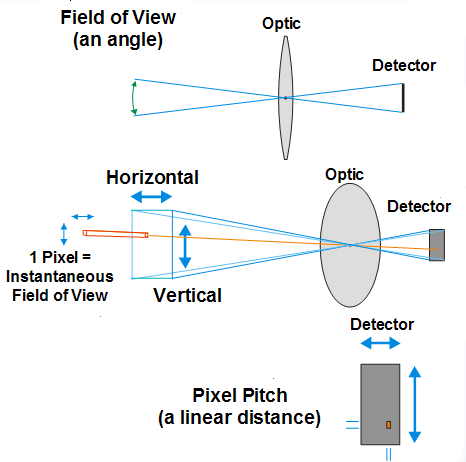EOIR Spatial Properties
When you choose EOIR as the Sensor Type on the Basic - Definitions page of a sensor's properties, you can select the Spatial tab to specify the following spatial properties for the selected band:
| Property | Description |
|---|---|
| Input |
Choose which two optical parameters are inputs, used to calculate a third parameter. The pairing options on the shortcut menu are:
|
| Auto Rebalance Parameters | If you select this check box, EOIR will rebalance the parameters to stay within the valid parameter limits. If you do not select this check box, EOIR will warn you when the settings would cause a calculation that is outside the valid parameter range. |
| Field of View |
Enter the following values:
EOIR uses these to determine the full angular extent of the sensor field of view (FOV). This property is not available for Input = Number of Pixels and Detector Pitch. |
| Number of Pixels |
Enter the number of sensor pixels in the field of view in the horizontal and vertical directions; the default is 128 for each. The number of pixels is limited to 6000 x 6000, to prevent an out-of-memory issue. By default, EOIR oversamples all images by four times. For example, a 1000 x 1000 image, rather than resulting in one million pixels, will produce 16 million simulated pixels because it is oversampled in both spatial dimensions. EOIR does this to properly capture higher spatial frequencies that could potentially be aliased. If you are using a high-memory machine, you can set the environment variable AGI_EOIR_HIGH_MEMORY to create up to 16000 x 16000 pixels. For limited machines, setting this environment variable may risk memory issues. The sensor model uses an ideal spatial response, which is unity within the IFOV (projected pixel area) and zero outside the IFOV. Each sensor pixel is, by default, oversampled four times in each direction, for a total of 16 samples per sensor pixel. You can change the amount of oversampling that EOIR performs by setting the environment variable AGI_EOIR_SENSOR_OSF to one of these values: 1x, 2x, 4x, 8x, 16x, or 32x. Smaller values will result in faster processing speeds but lower-fidelity spatial simulation and also artificial spatial artifacts. Larger values will result in slower processing speeds but higher-fidelity spatial simulation and reduced spatial artifacts. This property is not available for Input = Field-of-View and Detector Pitch. |
| Related Detector Parameters |
These are horizontal and vertical physical dimensions of a pixel at the focal plane. Enter values for the following parameters:
This property is not available for Input = Field-of-View and Number of Pixels. |
| Instantaneous Field of View | This is the angular extent of a single pixel in the horizontal and vertical directions, both in mrad. |
The following diagram provides a visual illustration of certain spatial parameters.
